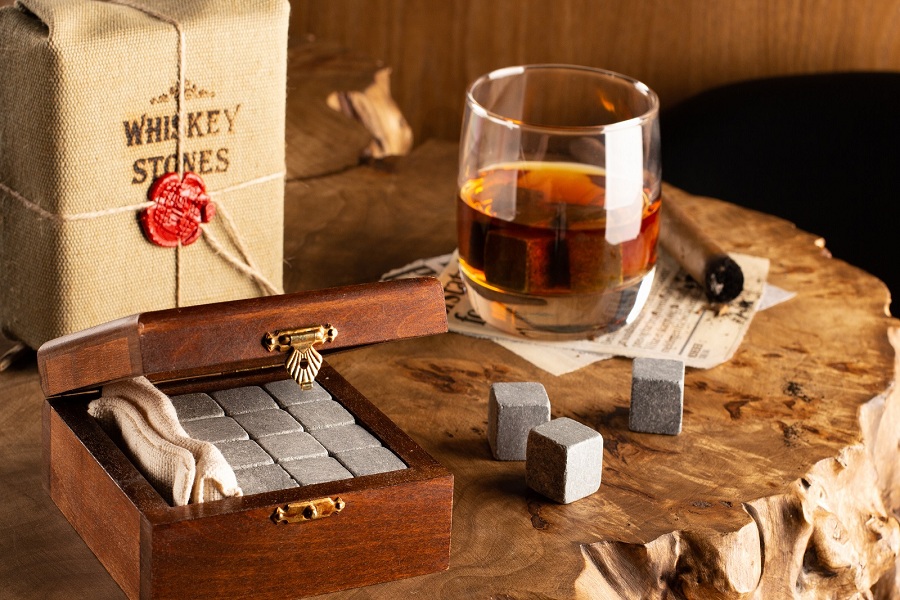Whiskey stones are reusable ice cubes that many people use to keep their whiskey cold without diluting the liquor. Most whiskey stones are made of soapstone, granite, and stainless steel.
If you know anything about whiskey stones, you may know the product is a topic of controversy within the whiskey industry. Some experts swear by ice; others swear by stones.
Even so, whiskey stones have a few main advantages over ice. They also have some disadvantages.
If you are not familiar with the product, this guide will explain how whiskey stones work. We will cover the history, how they are made and what materials whiskey stones are made of.
Lastly, we will cover the pros and cons. Let’s get started.
History of Whiskey Stones

There are a few different theories regarding the origin and history of whiskey stones.
The main theory takes place in Scotland. During the 20th century, travelers of the area spread rumors of how the scots came up with whiskey stones.
Scots wanted a way to cool their drink without diluting the whisky. Apparently, the scots would grab a few stones from a nearby river and drop them into their glass.
While the scots may very well have invented whiskey stones, it wasn’t until the 21st century when the product became popular.
Andrew Hellman invented Whisky Stones in 2007. He mentions that a particular item he found in his Swedish grandfather’s house influenced his invention.
Hellman found a set of stones in a pouch at his grandfather’s house. He later learned that during the 1900s, people hung small stones outside.
They would then use the stones to cool off hot liquids on the stove, such as soup.
During frequent visits to Scotland, Hellman learned more about whisky. The main thing he remembered about Scottish whisky (Scotch) was that the Scots did not recommend diluting their powerful whisky.
When he wondered if there was a way to cool the whisky without diluting it, he remembered his grandfather’s stones. This is how Whisky Stones originated.
How Are They Made?

Since there are several different kinds of whiskey stones, the manufacturing process will vary from product to product.
However, most whiskey stones are some kind of metamorphic rock, so the overall process will be similar.
The first step will involve obtaining whatever kind of stone the company uses to make whiskey stones. These materials will either be soapstone, granite, or marble, in rare cases.
The stone is then measured and marked to prepare for cutting. Since the shape of whiskey stones differs (they can come in spheres, cubes, etc.), this step will differ between manufacturers.
Many natural stones like soapstones are quite soft, so tools such as metal cutting blades will work fine for cutting the stone.
The stones will have some sharp edges and course areas that the factories will sand down. Once the stone is smooth on all sides, they are ready for use. Some stones are also polished.
Other stones on the market also have a more rugged shape; these stones are normally just chiseled, shaped, and polished.
What Are They Made Of?
There are a few different kinds of whiskey stones that are different materials. However, there are three main materials that whiskey stones are made of: soapstone, granite, and stainless steel.
Soapstone and granite are metamorphic rocks; they are not sedimentary rocks. Sedimentary rocks wear down easily.
Alcohol is a solvent, which will break down sedimentary rocks further. The rocks will also break down as they rub against each other.
However, metamorphic rocks like soapstone, granite, and even marble will not release any particles after wear and tear.
This is why most whiskey stones are composed of soapstone and granite (and, in rare cases, marble).
Soapstone
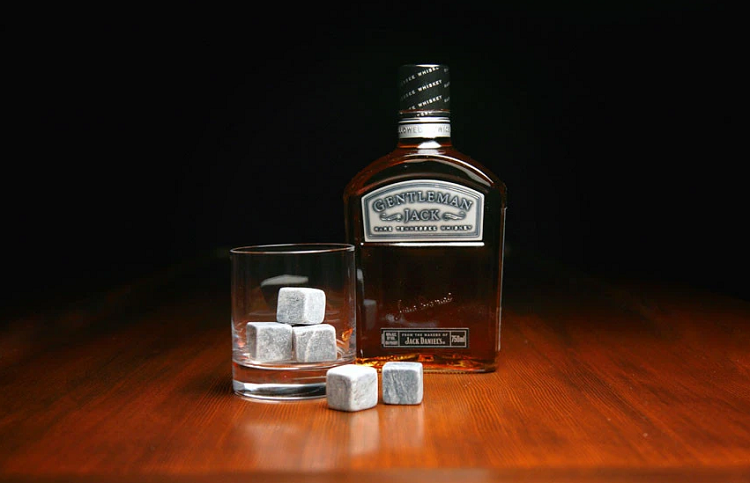
Soapstone whiskey stones are chiseled from rock and are nonporous. They have a more rugged look than other stones since they are denser and less perfectly shaped.
They work well as whiskey stones because they do not affect the flavor at all. Since soapstone is nonporous, no adverse aromas or substances will seep into your drink.
Furthermore, they are completely safe to use.
Granite
Granite whiskey stones are very similar to soapstone, except they are chiseled from granite rock. Granite stones have a few characteristics that differentiate them from other stones.
First of all, granite will not chill the whiskey the same way ice would. Instead, they have more of a cooling effect.
However, some whiskey enthusiasts prefer this since they can detect more of the drink’s flavors and undertones when it is not too cold.
On the other hand, granite will not make any drink ice cold unless you fill the glass with them. While the stones will work fine for drinking whiskey on the rocks, they will not work well for cocktails.
Stainless Steel
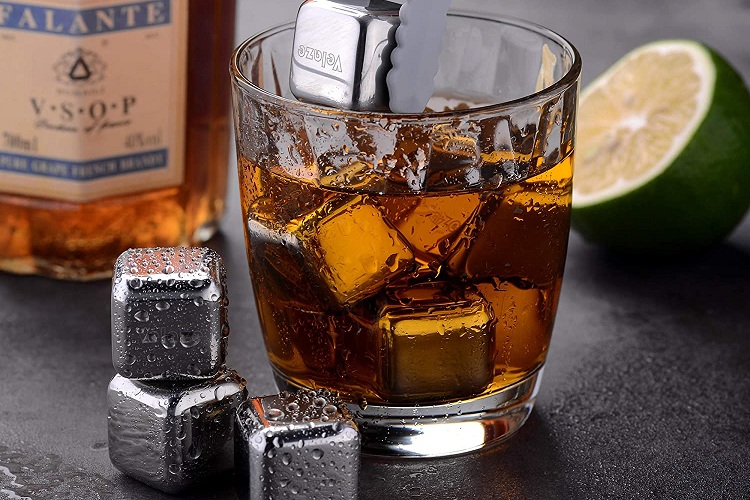
There are also stainless steel whiskey stones on the market. Many people prefer stainless steel stones since they can cool a drink much faster and greater than granite or soapstone. Stainless steel is the closest you can get to ice when it comes to temperature.
However, some stainless steel stone products will leave a metallic aftertaste in your mouth. For this reason, it is a good idea to do your research before buying a pair of stainless steel whiskey stones.
Pros and Cons
Now that we know the different kinds of whiskey stones let’s look at some of the product’s main pros and cons.
Whiskey Stones Will Not Dilute Your Drink
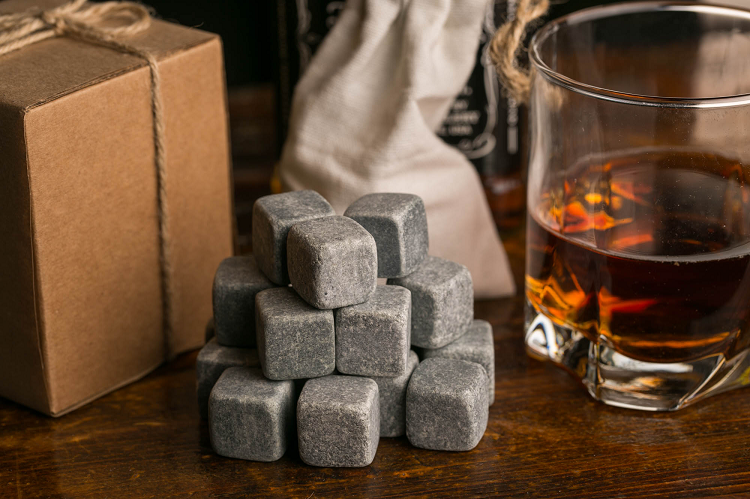
The main benefit of whiskey stones is that they cool the drink without diluting it. Nothing is worse than a watered-down whiskey, and whiskey stones solve that problem.
For people who like to take their time sipping and enjoying the drink, stones will be a much more attractive choice than ice.
The Stones Will Not Affect the Taste of Your Drink
A major downside of ice is that it can alter the taste of the whiskey. Ice is very porous. This fact means that flavors and aromas can seep into the ice, muting some of the richness from the drink.
Furthermore, if you make your ice with tap water, this can also alter the taste. As the ice begins to melt, the tap water will mix with the whiskey and infuse some odd, unpleasant flavors.
However, whiskey stones are made out of non-porous materials (soapstone, granite, and stainless steel).
Nothing from the whiskey will absorb into the whiskey stones. The stones will cool your drink and leave you with a rich, unaltered taste.
Whiskey Stones are Reusable
Another bonus of whiskey stones is that they are reusable. After you use them, simply handwash them and leave them to dry. You can use the stones as many times as you want.
Furthermore, the stones will freeze much more quickly compared to ice. While ice cubes take hours to form, whiskey stones will be ready after 30-40 minutes in the freezer.
Whiskey Stones Maintain a Constant Temperature Longer Than Ice

Many whiskey lovers prefer to use whiskey stones because they can maintain a constant temperature for a long time. Ice, on the other hand, will melt quite quickly.
When you use stones, you won’t have to worry about downing your drink before the ice melts. Whiskey stones will keep your drink at the perfect temperature for a good amount of time.
Whiskey Stones Will Never Be As Cold as Ice
Those who love an ice-cold drink will be disappointed with whiskey stones. Whiskey stones will never give your drink that harsh chill that ice can.
For this reason, avoid using whiskey stones for any sort of cocktail. Stick to the stones for drinking straight whiskey.
Stainless Steel Whiskey Stones Can Leave a Metallic Aftertaste
If you go with stainless steel whiskey stones, you may experience an odd, metallic aftertaste. When choosing these kinds of stones, be careful of the brand you go with.
You will need to do a bit of research to avoid the steel stones from affecting the flavor of your favorite whiskey.
Soapstone and Granite Stones May Damage Your Glass
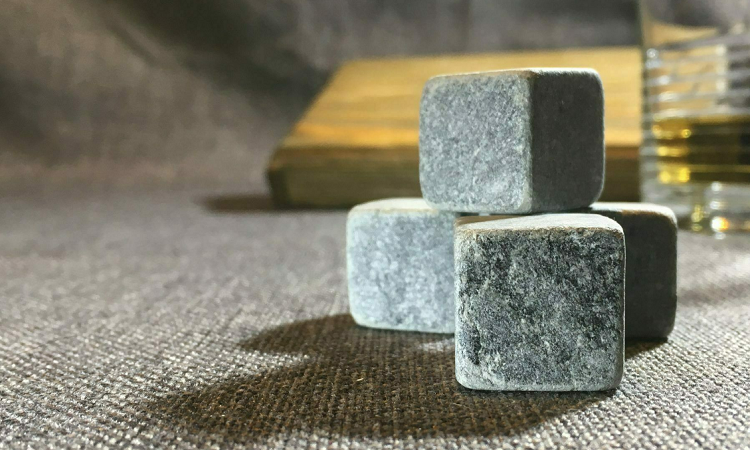
While whiskey stones are completely safe to use, there is a possibility that the stones will damage your glass. If you drop them from a certain height or angle, your glass could break.
Furthermore, granite is a bit harder than soapstone. Granite is more likely to scratch your glass than soapstone is.
To avoid any damage, try to use tongs or gently slide the stones into your drink.
It May Take a Few Minutes for the Stones To Cool Your Drink
The last downside of whiskey stones is that they do not work as fast as ice cubes do. In other words, you will need to wait a few minutes before your drink cools down.
While this may not be a big deal for some, others may find it annoying while serving drinks to guests.
Conclusion
Andrew Hellman invented Whisky Stones in 2007, and from there, hundreds of companies have made variations of the product.
Whiskey stones are generally made of different kinds of metamorphic rock such as soapstone, granite, and marble. The other main kind of whiskey stones is stainless steel stones.
There are a few advantages of whiskey stones. First of all, they can cool your drink without diluting it. Stones will also keep your drink at a consistent temperature for longer and will not affect the whiskey’s flavor.
However, there are some downsides. The stones will never be as cold as ice. Whiskey stones made of metamorphic rock may damage your glass.
Overall, whiskey stones are great for drinking whiskey straight.
Resources:

